NZ Schools vs Aus U18
So I rewatched the NZ Schools game. It wasn’t pretty viewing, as you’d expect. NZ Schools first three possessions of the game all led to turnovers: Verster throws a miss pass when it wasn’t on, leading to Pahulu going rather meekly into touch; then, Verster, playing under advantage, tries an attacking chip with zero deception (the subsequent attacking lineout is lost because of a baulk); in the third possession, Sinkinson passes out the back to an unexpecting Saumaki who drops the ball. When they finally decide to turn to the kick as everything else isn’t working, Norrie kicks it out on the full after it was passed back inside the 22 by Verster, leading to an attacking Australian lineout. When it rains, it pours. And it didn’t get much better after that, unfortunately. So it was a rough watch.
I thought I’d share some notes, if anyone would be interested in reading them. What stood out to me was the NZ Schools defence, especially its breakdown in communication at certain times, of which I’ll try to give a few examples. This was further compounded by some clever Australian attack, which was able to identify similar weaknesses in both NZ Schools and Barbarian U18 defence, in its earlier game.
The first Australia U18 try would be a good place to start. Gold has a lineout on the NZ 22, a simple throw to Langi in the middle pod leads into a straightforward Lemoto carry (where he pretty much demolishes Sinkinson). After two quick rucks inside the NZ 22, Grover, the Aussie 9, throws a long pass wide and this is the state of the NZ defensive line:
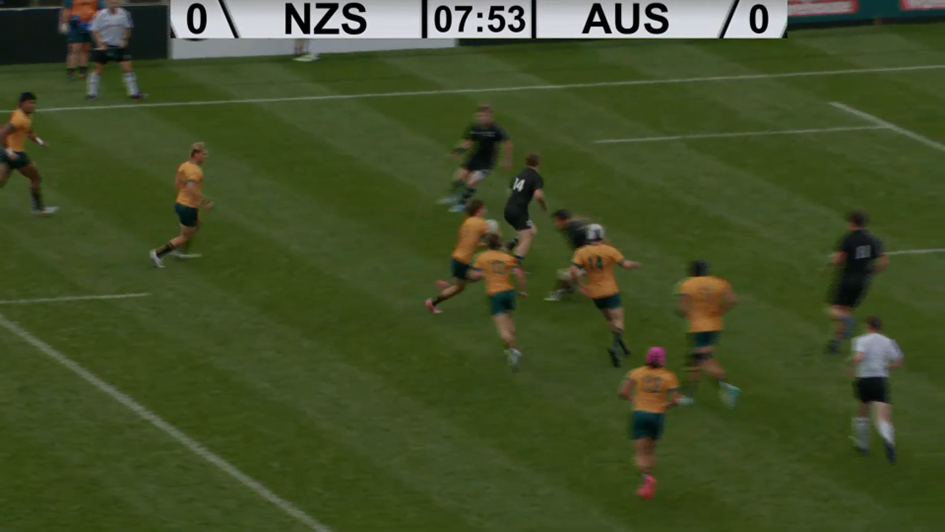
Aussie alignment and Kiwi chaos
Stanley has shot up to make the spot tackle in the hopes of disrupting the Aussie overlap, Guerin has his back turned to the play and Wallis is disconnected from the defensive line. The predictable result: Bassingthwaighte waltzes between Stanley and Wallis to run in pretty much untouched. The basis of this try is the power of the Lemoto carry and the Grover snipes around the ruck but it’s made easy by the lack of communication and connection between the NZ Schools defenders. When you have lone ranger-defenders (Stanley) going alone because the situation is so desperate, then there’s been a bad breakdown in defensive responsibilities.
Another example is the series of events which is probably most indicative of the game as a whole. It displays NZ Schools' lack of patience in attack, their lack of communication in defence and Aussie U18s ability to pounce on these mistakes. The sequence occurs around the 21 minute mark. After 15 minutes of hectic and erratic play, NZ Schools pulls off a great backline move, Norrie getting around his man and nicely putting Stanley through the gap, the passage of play leading to a Verster try. They have a good restart and are working themselves all the way up to the Aussie U18 tryline, only for Spratley to attempt an overambitious placing of the ball (when recycling the ball and setting up the next phase would’ve been the much safer bet), leading to a knock-on and an Australian goal-line dropout. In the subsequent sequence, Spratley has a run-up receiving the drop-out (not making a dent in the defensive line), Sinton throws a low pass to Stanley who drops it. A scrum ensues where the ball is quickly released by the Aussie 9 and for some reason, the NZ Schools scrum keeps pushing even though the ball is already on the other side of the field. This is the situation after the first ruck post- scrum:
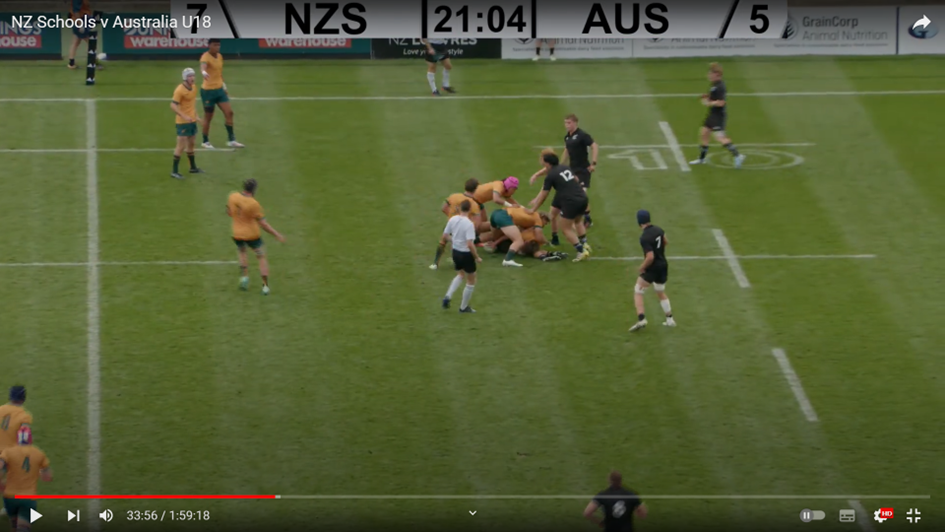
I’m pretty sure you can fit the Titanic through this defensive gap. More than enough room for HMS Lemoto.
There is about 15 metres of space between the first and second defenders outside the ruck (Keith and Spratley), which is, understandably, easily exploited by Heinz Lemoto. Again, the foundation is a breakdown in communication. Typically, the 9 shouts ‘break’ when the ball is released, signalling for his loose forwards to detach from the scrum and get into the defensive line. While I can’t pick everything up from the ref mic, Sinton does shout ‘hold’ twice before sprinting off. While Sinton is a very eager and willing defender for a 9, his first responsibility is still to organize and direct his forwards. It would be easy to blame Spratley for his tardiness but what really causes this wide defensive gap is a breakdown in communication between the 9 and his pack.
The irony of these examples is that I really don’t think Australia U18 needed this communicative breakdown to excel. They showed plenty of examples of clever play and identification of opportunities. I’ll limit myself to one example, a try in this game which was a near-exact copy of one in their game against the Barbarian U18s. The sequence starts with a missed kick at goal by Fowler. In the following restart, Lemoto carries Spratley with him for about five metres (there’s a theme here), after which Bassingthwaighte attempts a grubber through which deflects off of Saumaki into the open where it is collected by an Aussie U18 player. Again, an NZ Schools defender, Falloon, shoots up alone without anyone following or a cohesive line behind him:
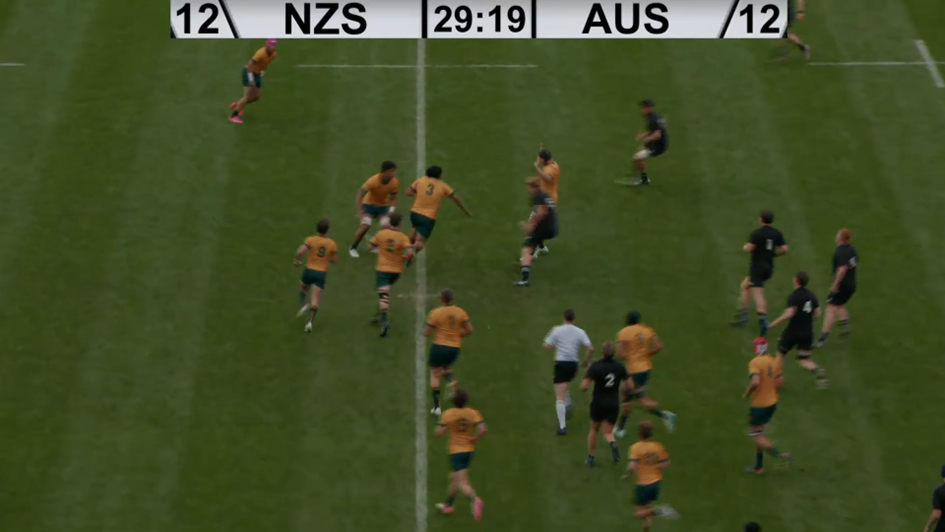
Ceci n’est pas une ligne défensive.
The resulting linebreak is easy enough and after a number of ineffective phases around the NZ 22, the Aussie U18s set up a short switch play where they slightly fracture the NZ Schools defence. What is interesting about this movement is that Australia U18 ran a very similar set against the NZ Barbarians U18s, where they played a couple of phases in the area around the Barbarian 22 before trying a switch pass against the grain. While the Barbarian U18s read this play much better – leading to Edwin Langi being smashed behind the gainline – the desired result was ultimately the same: the created expectation of a quick pass out of the ruck by the 9 and the added attention to possible switch plays. Then, what Grover was really looking for was the lock 5 as the pillar defender:
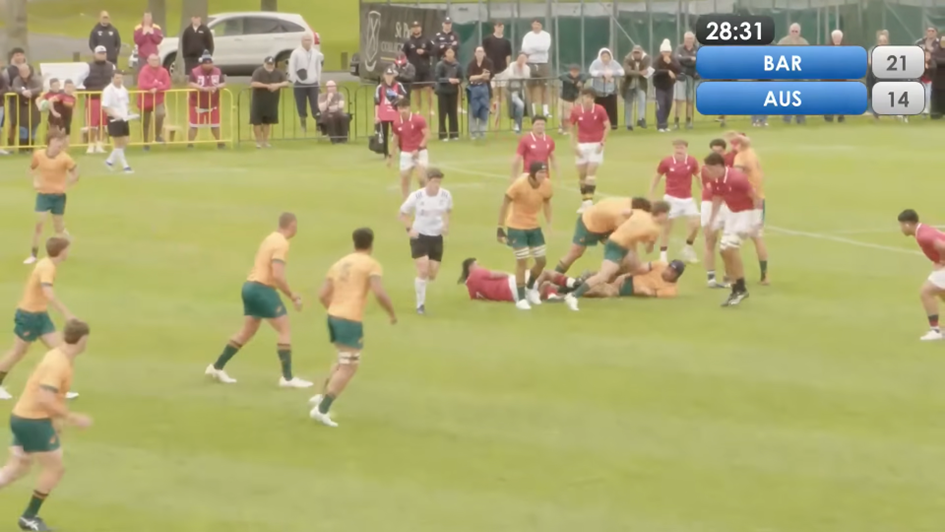
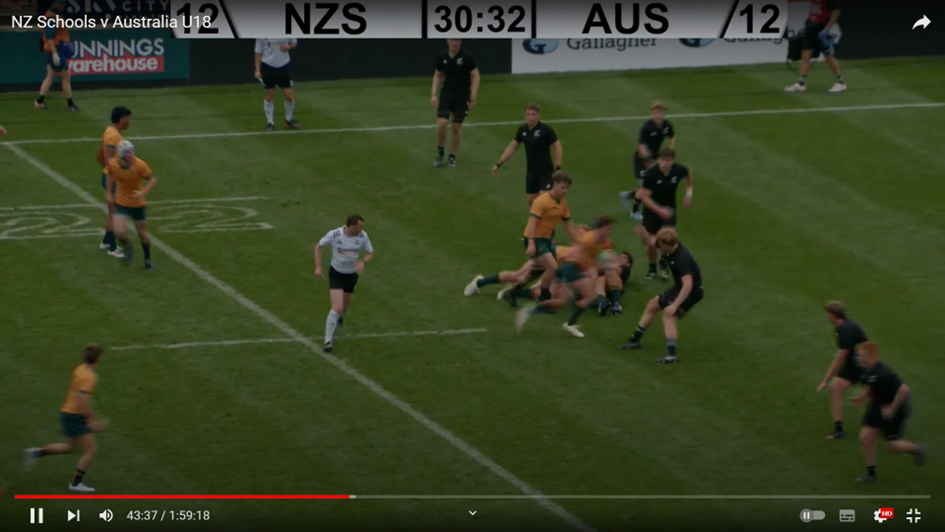
Spot the difference. Grover identifies the 5 lock as pillar defender and sneaks through, both sequences leading to tries.
Both Falloon and Frazer Brown, the Barbarian U18 5 lock, were tasked throughout their games with being aggressive defenders, shooting out of the line and putting pressure on the opposition playmakers. I think that Grover is aware of the fact that this responsibility makes their role as pillar defenders more complicated, taking advantage of this responsibility-overload to sneak through around the ruck. This was not so much a breakdown in NZ Schools communication as it was beautifully executed manipulation of the defence.
So, those are some things I noticed and found interesting in the game. I still don’t think this is a bad NZ Schools team though, by any means. Guerin, Pahulu, Stanley and Norrie all seem like supremely talented athletes. Sinton, although he made a lot of mistakes in this game, is still a quality player who will hopefully learn a lot from the experience. Aio Keith always impresses me when I see him play, if only for the sheer levels of shithousery he gets up to. The forwards will bulk up and get their chances. The team as a whole just seemed to be a little underprepared, of which I think the lack of communication is a prime symptom.
Full Match
If NZ Rugby wants to keep its current team structures intact, it would probably be best to have the NZ Schools team and NZ Barbarians U18s play against each other in a genuine match. I know they played and trained together in camp but a genuine game would have a lot more intensity and would serve as proper preparation for the other games. The upcoming game against the Māori U18 team should be a good contest.
I know this is way too much text and probably not in the spirit of the forum. But what can I say, I like writing and I like reading. Maybe there are others who are the same. Either way, I think I’m going to take a little break now. I’ve spent way too much time on watching these games and writing these posts. Good fun though.